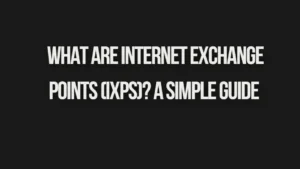Big Picture: Organisations rely on robust monitoring tools, strong authentication protocols, and prompt delisting procedures to mitigate the disruption caused by IP blacklisting.
Table of Contents
ToggleSmart Moves: Taking a proactive approach — including diligent reputation management and expert support — is vital for minimising the risk of IP blacklisting and safeguarding digital operations.
What’s IP blacklisting all about?
IP blacklisting blocks specific internet addresses. Security administrators use this method. They prevent certain IP addresses from accessing networks, servers, or services. The core goal is protection against harmful sources.
Admins add IP addresses to a blacklist when there’s a good reason — usually because those addresses have been spotted doing harmful things online, like sending spam or trying to break into systems.Examples include launching cyberattacks like DDoS. Other examples are brute-force login attempts or sending spam. Content scraping without permission also triggers blacklisting. Distributing malware or violating terms of service are common causes.
Different systems enforce IP blacklists. Network firewalls frequently apply these rules. Security gateways also block traffic from listed addresses. Email servers commonly use specialized blacklists. RBLs help filter spam from known bad sources. Web applications might integrate blacklists too. This blocks attackers before they reach the application layer.
IP blacklisting differs fundamentally from whitelisting. Blacklisting blocks only identified bad actors. It generally permits all other traffic by default. Whitelisting takes the opposite approach. Whitelisting is inherently more restrictive.
Organizations typically combine blacklisting with other security layers. Effective additions include intrusion detection systems and behavioral analysis. Strong authentication methods also complement blacklisting. Together, these measures create a stronger defense. IP blacklisting remains a vital, reactive security tool. It helps filter known threats at the network perimeter. Systems deny access based on the traffic’s origin point.
Why do IPs get blacklisted?
IPs don’t just end up on blacklists by accident. There’s usually a reason—or a few. Here’s what typically lands an IP in hot water:
Spam Overload: Sending bulk emails no one asked for or ignoring unsubscribe requests? That’s a fast track to a spam complaint, and blacklisting often follows. Abusix points out that recipient complaints are a major trigger.
Malware Mischief: If your IP is tied to phishing scams or malware, it’s getting flagged. SEON says IPs linked to phishing URLs are prime blacklist targets.
Brute Force Blunders: Too many failed login attempts can scream “hacker,” leading to a blacklist entry.
Tech Slip-Ups: Messy server setups, like missing reverse DNS records, can raise red flags. WhatIsMyIPAddress notes that technical glitches often cause these listings.
Shared IP Woes: Using a shared IP? Someone else’s bad behaviour could drag you down too. GlockApps suggests dedicated IPs for serious senders.
Knowing what’s behind blacklisting helps businesses zero in on fixes and avoid trouble down the line.
The fallout of a blacklisted IP
When an IP gets blacklisted, it’s not just a tech headache—it can hit a business where it hurts. LinkedIn lays it out: less website traffic, blocked emails, and a bruised reputation. Here’s the damage in detail:
Email Chaos: Your emails might end up in spam folders—or not delivered at all. InboxAlly warns this can tank marketing efforts and client relationships.
Website Woes: Blacklisted IPs can get blocked by search engines or security tools, slashing your site’s visibility.
Money Down the Drain: Lost deals and the cost of fixing the mess can add up fast. IPTrading says blacklisted IPs even hurt the value of IPv4 blocks.
Trust Takes a Hit: Getting associated with spam or malware doesn’t exactly build confidence — it can make people see you as an unreliable or risky partner.
Spotting a blacklisted IP
Catching a blacklisting early can save a ton of trouble. Businesses use a few tricks to stay on top of it:
Blacklist Checkers: Tools like MXToolbox or DNSChecker let you scan your IP against major blacklists in seconds.
Bounce Clues: If emails bounce back with messages mentioning a blacklist, that’s a dead giveaway. GlockApps says these messages are gold for pinpointing the issue.
Reputation Watchdogs: Services like IPTrading’s checker keep tabs on your IP’s status across dozens of lists.
Feedback Loops: Big email providers like Microsoft share spam complaint data, helping spot risks early. Fasthosts swears by these loops for server health checks.
Getting off a blacklist:
Step 1: Pinpoint the blacklist and cause
First, figure out which blacklist you’re on using tools like DNSChecker. Then, hit up the blacklist’s site to see why you’re listed—spam, malware, or something else?
Step 2: Fix the problem
You can’t just beg for delisting without cleaning house. That means:
Locking Down Security: Kick out any malware or shore up weak systems.
Cleaning Up Email Habits: Scrub your email lists, respect unsubscribes, and set up authentication like SPF and DKIM. IPTrading says these protocols are non-negotiable.
Sorting Tech Issues: Fix reverse DNS or server configs gone wrong.
Step 3: Ask for a second chance
Most blacklists have a delisting process—follow it to the letter, showing proof you’ve fixed the issue. Spamhaus, a big name in blacklists, warns against rushing this step without proper fixes, or you’ll just end up back on the list.
Step 4: Call in the pros
If it’s a messy case, enterprises often tap their email service provider or hire experts. DuoCircle points out that third-party SMTP services can scrub emails and dodge ISP blacklists.
John Doe from N-able adds, “Outbound email filters can catch spam accounts in the act, slashing your chances of getting blacklisted.”
Stopping blacklisting before it starts
The best way to deal with IP blacklisting is to stop it from the very start. This means being active about how your business works online. By doing a few simple things, companies can protect their name, build trust, and keep their online services running well.
Without the protection of tools such as SPF, DKIM and DMARC, even genuine emails may be misjudged as spam or phishing emails. This will quickly result in the sending IP address being blacklisted. Using these tools can ensure that emails are checked correctly.
Another key step is to watch IP reputation. An IP address is like a digital credit score. It affects how others see your business online. Services like AppTrana show an IP’s status in real time. This makes it easy to spot warning signs early. As Jane Smith from Imperva says, watching IP activity over time lets businesses spot odd things, like traffic jumps or abuse complaints, and fix them before they cause big problems.
For businesses that send a lot of emails or have many website visitors, a dedicated IP address is worth thinking about. Unlike shared IPs, which can be hurt by the behavior of others, a dedicated IP gives full control of online reputation. This is very important for industries like e‑commerce or marketing. In those fields, one bad actor can hurt the reputation of an IP range. A dedicated IP gives a buffer, making it less likely that a business will be punished for someone else’s behavior.
Adding an outbound filter service is another way to protect an IP. Tools like N‑able Mail Assure review outgoing emails for spam or malware. They are like “quality inspection points” before emails are sent out, specifically intercepting those problematic or seemingly odd information. In this way, threats are blocked from the source, and enterprises can naturally significantly reduce the risk of email ips being blocked.
Finally, geo‑blocking can be a very strong safeguard, especially for industries that often face cybercrime, like e‑commerce or banking. By blocking traffic from areas with many botnets or hackers, businesses can reduce threats. According to Indusface, geo‑blocking is a strong way to protect sensitive data and keep a clean online name.
Leaning on third-party help
Plenty of enterprises offload the heavy lifting to third-party services. These pros bring:
Round-the-Clock Monitoring: Platforms like SEON dish out real-time data to spot risky IPs.
Auto Delisting: DuoCircle handles delisting grunt work, keeping your emails flowing.
Reputation Smarts: Imperva serves up IP risk scores and attack details to guide your next move.
Spam Feedback: Fasthosts hooks you up with spam complaint data to stay proactive.
These services let businesses focus on their core work while experts keep blacklisting at bay.
Why reputation intelligence matters
Reputation intelligence is like having a crystal ball for your IP’s status. It tracks behaviour over time to spot trouble brewing. Imperva explains it gives you risk scores and attack types, so you know what to tackle first.
Take AppTrana—it taps databases like Spamhaus and HoneyPot to block bad IPs with minimal collateral damage. For industries like e-commerce, where fraud’s a constant threat, this is a lifesaver.
The catch with IP blacklisting
Blacklisting isn’t perfect. It’s got some quirks:
False Alarms: Good IPs can get flagged by mistake, messing up your day. Enthec suggests pairing blacklists with whitelists to play it safe.
IP Swaps: Bad actors keep switching IPs to dodge lists.
Dynamic IPs: ISPs shuffle IPs, so innocent users might inherit a bad one.
Gaps in Coverage: Blacklists don’t catch everything, so you need firewalls and other tools too.
A multi-layered security setup helps enterprises work around these hiccups.
Industry-specific blacklisting battles
Every industry’s got its own blacklisting headaches:
E-commerce: Blocks IPs tied to carding or bots to stop fake orders.
Finance: Uses geo-blocking to shut out fraud from risky regions.
Healthcare: Keeps patient data safe by blacklisting cybercrime IPs.
Media: Stops VPNs from sneaking past regional locks.
Each sector tweaks its approach to keep things secure without alienating legit users.
The future path of IP blacklist management
IP blacklist management is an important line of defense for network security. It acts like a gatekeeper, preventing known malicious addresses from accessing the network. However, the ways of cyber threats are always changing. Attackers are constantly looking for ways to bypass the traditional blacklist. Therefore, the management of IP blacklists also needs to move forward, becoming smarter and more efficient.
Artificial intelligence (AI) and machine learning can discover hidden threat patterns. These patterns are difficult to capture by the old methods. The system can automatically identify suspicious IP addresses more quickly. These addresses may not have launched large-scale attacks yet, but there are already signs of danger. Automatic analysis enables faster and more accurate detection of threats. The update of the blacklist can also be more timely.
More information needs to be shared among security agencies. It is very difficult to fight against the cyber threats of globalization alone. In the future, different organizations and even countries need to enhance cooperation. Everyone needs to exchange threat intelligence safely. The shared information should not only include bad IP addresses, but also how the attack occurred. This kind of cooperation can enable everyone to have a more comprehensive understanding of the threat. The defense system will also respond more quickly to new types of attacks.
Future interceptions need to be more precise and take into account more situations. Simply blocking an IP address can sometimes accidentally hurt good people, especially those shared or cloud service IP addresses. Future systems need to better understand the true intentions behind IP addresses. When making a judgment, more aspects will be considered, such as the past performance of this IP, exactly what it has done, and who it intends to attack. The blacklist might be divided more finely, such as distinguishing between those who send spam, those who specifically scan for vulnerabilities, or those who directly attack. The system may score based on the level of risk rather than simply allowing or blocking. This can help administrators control access more precisely and reduce disturbances to normal users.
The blacklist needs to be closely coordinated with other security tools. The IP blacklist cannot be isolated. It should be deeply connected with firewalls, intrusion detection systems, security monitoring platforms, etc. Once a malicious IP is detected, the system can automatically initiate the preset response actions. These actions may include immediately blocking the connection, or limiting its traffic speed, or initiating a more in-depth inspection. Automation can significantly shorten the response time and reduce the working pressure of safety personnel.
FAQs
1. What is IP blacklisting and what causes it to occur?
It takes place when an IP address gets eliminated from networks or email servers after being flagged for criminal activity, such as spam or malware. undesirable emails, incorrectly set up servers, or malicious content are some of the causes.
2. How can companies find out if their intellectual property has been blacklisted?
They check against blacklists using programs like DNSChecker and MXToolbox. They are also alerted by bounced emails or feedback loops.
3. How can an IP that has been blacklisted be fixed?
Locate the blacklist, address the problem (such as malware or improper email practices), and then ask to be delisted with documentation of your cleanup.
4. How can businesses stay off a blacklist?
Choose dedicated IPs, keep an eye on IP reputation, use email authentication (SPF, DKIM, DMARC), and filter external emails.
5. What is the pros of using third-party services?
To bring down the risk of blacklisting, services as DuoCircle and Imperva provide reputation insights, auto-delisting, and monitoring.




Wonderful web site. Lots of useful information here. I am sending it to a few friends ans also sharing in delicious. And certainly, thanks for your effort!
Thanks for the sensible critique. Me & my neighbor were just preparing to do some research on this. We got a grab a book from our local library but I think I learned more clear from this post. I’m very glad to see such magnificent info being shared freely out there.
I have learn a few excellent stuff here. Certainly value bookmarking for revisiting. I surprise how much effort you put to create this type of fantastic informative web site.
Some really interesting information, well written and generally user friendly.
Precisely what I was searching for, regards for putting up.
Some truly interesting points you have written.Assisted me a lot, just what I was searching for : D.
magnificent put up, very informative. I’m wondering why the opposite specialists of this sector don’t notice this. You must continue your writing. I’m sure, you have a great readers’ base already!
Wohh precisely what I was searching for, thankyou for putting up.
You should take part in a contest for one of the best blogs on the web. I will recommend this site!